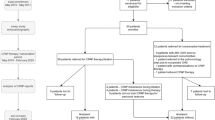Abstract
Patients suffering from severe cardiac failure develop breathing pattern disorders, often. Polysomnography demonstrates periodic breathing (Cheyne-Stokes respiration) with or without central apnea. Consecutive oxygendesaturations may cause cardiac dysrhythmia and further worthening of cardiac function. Sleep-architecture is disturbed and patients complain same as patients with sleep-apnea do. Treatment of choice is nasal mechanical ventilation in patients with sleep apnea. However, mechanical ventilation causes a changement of intrathoracic pressure. In this trial we examined the influence of non-invasive mechanical ventilation (n-CPAPor n-BIPAP) on hemodynamics in pts. Suffering from severe dilatative cardiomyopathy (NYHA III-IV), who showed breathing pattern disorders. In 25 patient suffering from severe dilatative cardiomyopathy with polysomnographically registered periodic breathing, we performed a nasal mechanical ventilation by n-CPAP (pressure level 6 cm H20) and n-BIPAP with various pressure levels (6/0; 10/0; 10/6 cm H20 in-/ex-spiratory) under simultaneous invasive registration of hemodynamics during night. In 22 pts. N-CPAP caused a further worsening and deterioration of hemodynamics and of dyspnea in our patients. Applications of IPAP showed in 20 cases an improvement of hemodynamics and of sleep-architecture. As hemodynamics changes in these patients and the influence of a non-invasive mechanical ventilation are not be predictable individual titration of pressures by simultaneous invasive hemodynamic control during night seems to be necessary.
Zusammenfassung
Bei Patienten mit schwerer myokardialer Insuffizienz findet sich häufig das Auftreten einer periodischen Atmung (Cheyne-Stokes-Atmung) mit oder ohne zentraler Apnoe. Als Folge der schlafbezogenen Atmungsstörungen treten rezidivierend zyklische EntSättigungen, häufige Arousal-Reaktionen und damit Störungen der Schlafarchitektur auf. Diese schlafbezogenen Atmungsstörungen können die Prognose der Patienten verschlechtern.
Bei 25 Patienten mit dilatativer Kardiomyopathie im Stadium NYHA III-IV wurde der Einfluß einer nächtlichen nichtinvasiven Beatmung auf die Hämodynamik und die Atmungsstörungen untersucht. Bei allen Patienten war plysomnographisch eine Cheyne-Stokes-Atmung diagnostiziert. Unter invasiver hämodynamischer Kontrolle wurde bei allen Patienten eine nächtliche nasale Überdruckbeatmung mit verschiedenen in- und exspiratorischen Drucken eingeleitet (nCPAP-Druck 6 cm H20, nBlPAP-Beatmung 6/0 cm H20, 10/0 cm H20, und 10/6 cm H20 (in-/exspiratorischer Druck). Bei 22 Patienten kam es unter Anwendung eines positiv endexpiratorischen Druckes zu einer Verschlechterung der Hämodynamik. Die nBIPAP-Therapie mit Drucken von 6/0 und 10/0 cm H20 zeigten bei 20 Patienten eine Verbesserung der Hämodynamik sowie eine Verbesserung der schlafbezogenen Atmungsstörungen.
Similar content being viewed by others
References/Literatur
Broughton, R., R. Baron: Sleep patterns in the intensive care unit and on the ward after acute myocardial infarction. Electroencephalogr. Clin. Neurophysiol. 1978;45:348–360.
Dark, D. S., S. K. Pingleton, G. R. Kerby et al.: Breathing pattern abnormalities and arterial oxygen desaturation during sleep in the congestive heart failure syndrome: improvement with medical therapy. Chest 1987;91:833–836.
Findley, L. gnJ., C. W. Zwilich, S. Ancoli-lsrael et al.: Cheyne-Stokes breathing during sleep in patients with left ventricular heart failure. South Med. J. 1985; 78: 11–15.
Harrison, T. R., C. E. King, J. a. Calhoun, W. G. Harrison: Congestive heart failure: paroxysmal dyspnea at the onset of sleep. Arch. Intern. Med. 1984; 53: 891–910.
Lange, R. L., H. H. Hecht: The mechanism of Cheyne-Stokes respiration. J. Clin. Invest. 1962; 41 (1): 42–52.
Lown, B., M. Tykocinski, A. Garfein, P. Brooks: Sleep and ventricular premature beats. Circulation 1973; 43:691–701.
Orr, W. C., M. L. Stahl, T. Whitsett, E. Langevin: Physiological sleep patterns and cardiac arrhythmias. Am. Heart J. 1979; 97: 128–129.
Rosenberg, M. J., E. Uretz, P. Denes: Sleep and ventricular arrhythmias. Am. Heart J. 1983; 106: 703–709.
Hanly, P. J., W. W. Millar, D. G. Steljes, R. Baert, M. A. Frais, M. H. Kryger: Respiration and abnormal sleep in patients with congestive heart failure. Chest 1989;96:480–488.
Naughton, M. T., P. P. Liu, D. C. Bernard, R. S. Goldstein, T. D. Bradley: Treatment of congestive heart failure and Cheyne-Stokes respiration during sleep by continuous positive airway pressure. Am J Respir Crit Care Med 1995; 151:92–97.
Davies, R. J., K.J. Harrington, O.J. Ormerod, J. R. Stradling: Nasal continuous positive airway pressure in chronic heart failure with sleep-disordered breathing. Am J Respir Crit Care Med 1993; 147:630–634.
Thalhofer, S., P. Dorow, S. Schüler, R. Hetzer: Sauerstoffsättigung und Schlafarchitektur bei Patienten mit dilatativer Kardiomyopathie. Pneumologie 1991;45:259–260.
Dorow, P., S. Thalhofer, S. Schüler, R. Hetzer: Einfluß der nasalen Überdruckbeatmung bei Patienten mit dilatativer Kardiomyopathie (NYHA III-IV). Pneumologie 1993; 47:780–781.
Author information
Authors and Affiliations
Rights and permissions
About this article
Cite this article
Thalhofer, S., Dorow, P. Influence of nasal positive pressure ventilation on hemodynamics in patients with severe dilatative cardiomyopathy (NYHA III-IV). Sleep Breath 1, 9–14 (1996). https://doi.org/10.1007/BF03038941
Issue Date:
DOI: https://doi.org/10.1007/BF03038941




